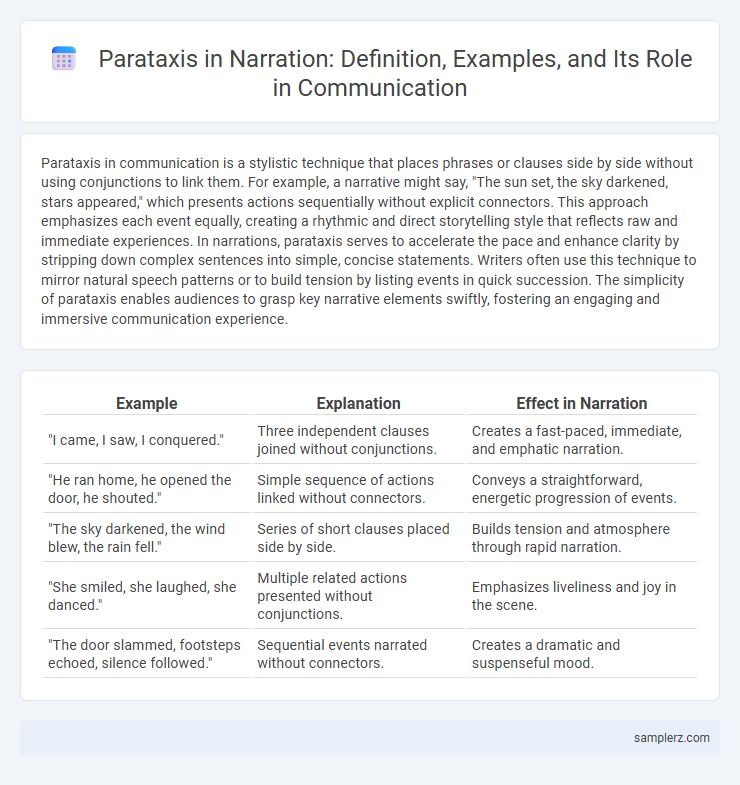Parataxis in communication is a stylistic technique that places phrases or clauses side by side without using conjunctions to link them. For example, a narrative might say, "The sun set, the sky darkened, stars appeared," which presents actions sequentially without explicit connectors. This approach emphasizes each event equally, creating a rhythmic and direct storytelling style that reflects raw and immediate experiences. In narrations, parataxis serves to accelerate the pace and enhance clarity by stripping down complex sentences into simple, concise statements. Writers often use this technique to mirror natural speech patterns or to build tension by listing events in quick succession. The simplicity of parataxis enables audiences to grasp key narrative elements swiftly, fostering an engaging and immersive communication experience.
Table of Comparison
| Example | Explanation | Effect in Narration |
|---|---|---|
| "I came, I saw, I conquered." | Three independent clauses joined without conjunctions. | Creates a fast-paced, immediate, and emphatic narration. |
| "He ran home, he opened the door, he shouted." | Simple sequence of actions linked without connectors. | Conveys a straightforward, energetic progression of events. |
| "The sky darkened, the wind blew, the rain fell." | Series of short clauses placed side by side. | Builds tension and atmosphere through rapid narration. |
| "She smiled, she laughed, she danced." | Multiple related actions presented without conjunctions. | Emphasizes liveliness and joy in the scene. |
| "The door slammed, footsteps echoed, silence followed." | Sequential events narrated without connectors. | Creates a dramatic and suspenseful mood. |
Understanding Parataxis in Narrative Communication
Parataxis in narrative communication involves placing clauses or phrases side by side without using coordinating or subordinating conjunctions, enhancing immediacy and rhythm in storytelling. This technique allows readers to interpret relationships between ideas independently, fostering active engagement with the narrative. Understanding parataxis helps communicators craft concise, impactful messages that rely on juxtaposition rather than explicit logical connectors.
The Role of Parataxis in Storytelling
Parataxis in storytelling enhances narrative clarity by placing clauses or phrases side by side without conjunctions, creating a rapid, direct flow that immerses readers in immediate experiences. This technique allows authors such as Ernest Hemingway to evoke tension and urgency through succinct, fragmented sentences that mirror natural thought patterns and dialogue rhythms. The use of parataxis streamlines communication, emphasizing the sequence of events and emotional impact over complex syntactic connections.
Famous Examples of Parataxis in Literature
Famous examples of parataxis in literature include Ernest Hemingway's *The Old Man and the Sea*, where short, simple sentences are placed side by side to create a rhythmic and direct narrative style. Another notable instance is in William Faulkner's *The Sound and the Fury*, which employs parataxis to reflect fragmented stream-of-consciousness narration. These examples highlight how parataxis enhances immediacy and clarity in storytelling by presenting ideas without hierarchical connections.
Parataxis vs. Hypotaxis: A Comparative Overview
Parataxis in narration employs short, simple sentences placed side by side without conjunctions, creating a rapid, fragmented flow, as seen in Hemingway's minimalist style. Hypotaxis, by contrast, uses subordinating conjunctions and complex sentences to establish clear relationships and hierarchical connections between ideas. This comparative overview highlights how parataxis emphasizes immediacy and raw experience, while hypotaxis promotes logical clarity and detailed explanation in communication.
Enhancing Dialogue with Paratactic Structure
Parataxis enhances dialogue by presenting ideas in simple, straightforward sentences that mimic natural speech patterns, creating a more authentic and engaging interaction. This technique uses short, often equal-length clauses placed side by side without conjunctions, such as "I came, I saw, I left," to convey a sense of immediacy and rhythm. Writers employ paratactic structures to increase clarity and emotional impact in conversations, making characters' voices feel more realistic and dynamic.
Parataxis in Modern Fiction Narration
Parataxis in modern fiction narration often presents short, independent clauses without conjunctions, creating a rapid, fragmented rhythm that reflects a stream-of-consciousness style. This technique, exemplified in works by authors like Ernest Hemingway and Cormac McCarthy, conveys immediacy and realism in dialogue and thought processes. The absence of subordinating conjunctions emphasizes action and observation, fostering a raw and unfiltered narrative voice.
Effects of Parataxis on Narrative Pace and Tone
Parataxis in narration accelerates the narrative pace by presenting clauses or phrases in a simple, straightforward sequence without subordinating conjunctions. This technique creates a rapid, staccato rhythm that generates urgency and immediacy, enhancing the emotional intensity of the story. The tone often becomes more direct and impactful, reflecting raw, unfiltered experiences.
How Parataxis Shapes Reader Interpretation
Parataxis in narration uses short, simple sentences or phrases placed side by side without conjunctions, creating a rapid, fragmented rhythm that influences reader interpretation by emphasizing immediacy and simplicity. This structure encourages readers to actively connect ideas, which can heighten emotional impact and create multiple layers of meaning. Famous examples include Ernest Hemingway's writing style, where parataxis shapes a sparse yet powerful narrative voice.
Parataxis in Oral Traditions and Folk Narratives
Parataxis in oral traditions and folk narratives manifests through the use of simple, coordinated phrases without explicit connectors, creating a rhythmic and memorable storytelling flow. This technique enhances listener engagement by emphasizing actions and events in a straightforward, sequential manner, characteristic of many cultural narratives globally. The repeated structural patterns in paratactic narration support communal memory and facilitate the transmission of cultural values across generations.
Crafting Paratactic Narration: Tips for Writers
Paratactic narration employs concise, straightforward sentences placed side by side without conjunctions, such as "He came. He saw. He conquered." Writers crafting paratactic narration should focus on rhythmic pacing and clarity, using short, impactful statements to enhance tension and immediacy. Emphasizing sensory details and actions over complex syntax helps maintain reader engagement through a vivid, direct storytelling approach.

example of parataxis in narration Infographic
 samplerz.com
samplerz.com